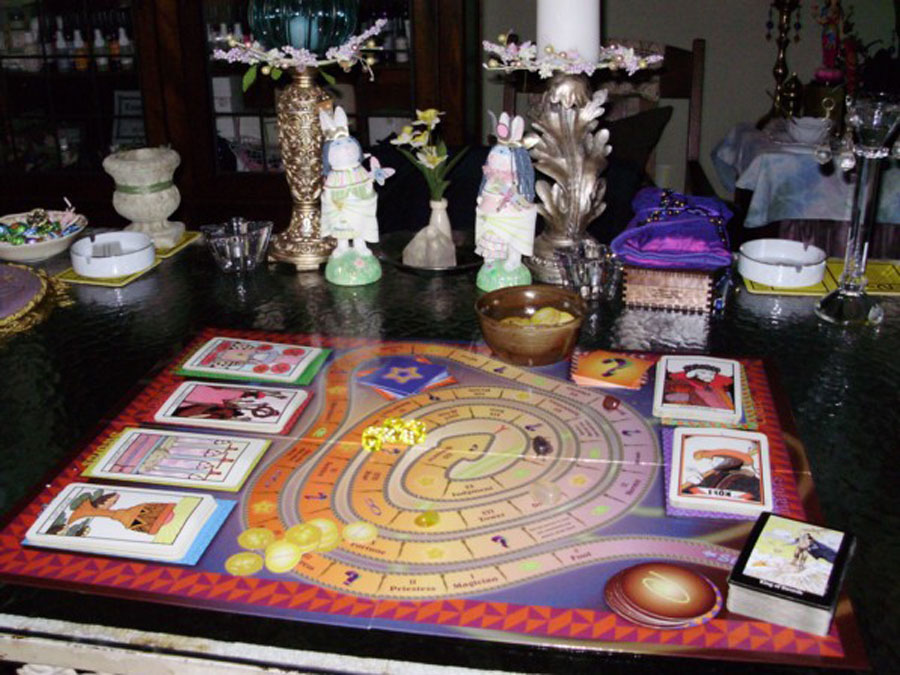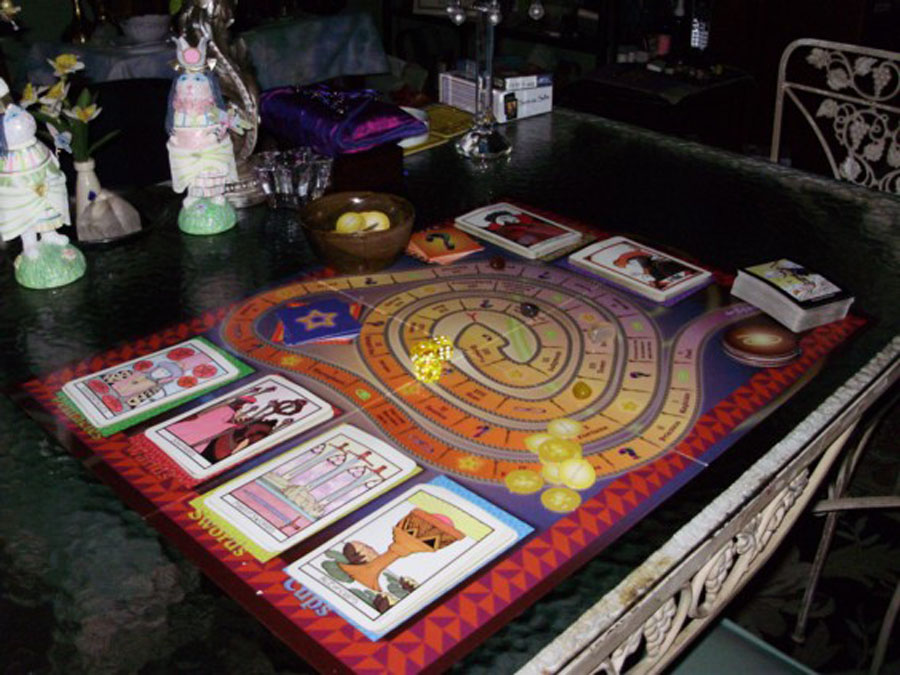
Finally there’s something for tarotists that comes in a BIG box. Tarot teacher and life coach Jude Alexander has created a unique and innovative interactive tarot board game that provides benefits to players at every level of expertise.
The kit includes the playing board, game pieces (tumbled stones), three dice, 36 activity cards, 90 blessing coins, player sheets, a keyword tarot deck and instructions. The game can be played alone, and the instructions state that up to nine players can participate. Two tarot decks are needed – one for the board separated into suits, and another for performing instructions that require a full deck.
Players are instructed to compose a question, and the reading is constructed as a player acquires tarot cards through the game. Players roll the dice and move their pieces around a snake-like spiral path to the center, performing whatever activity is indicated in the space in which they’ve landed.
It’s a good idea to play a solo round to get an overview of the variety of rules and instructions before initiating a group game. In my introductory private game, I found the game’s design to be a bit nebulous – is it for teaching and learning, or is it for getting a personal reading? A number of variations are offered at the end of the instruction sheet, and it is fairly easy to create additions and modifications.
Group Test Game
Three ladies gathered at my house on Spring Equinox. After a short Ostara ritual, we played The Tarot Game. Player skills ranged from experienced beginner to adept. I asked the ladies for comments afterwards.
Amie said “I learned about the cards, and I like hearing other opinions about them.” A book was available for interpretations, and the consensus was that the game is an excellent refresher, review and reminder of possible card meanings and a great learning tool.
The ladies agreed that instructions to sing and dance were silly and “lowered the tone of the game.” (Linda and I broke out into a verse of “After the Gold Rush” without prompting in any case.) Linda and Tracy, both experienced readers, questioned the idea of using the game for a tarot party, especially if, as Tracy pointed out, “people were there to get hammered.” We agreed that four players is a realistic and ideal maximum because each turn required other players to listen and offer ideas to the player. Tracy thought it would be challenging to be a game leader for a group of clients, unless they were really good clients. She thought a small family group would be best.
We all thought the concept was really cool, but in spite of the high quality substance, there were reservations about the content of the gaming materials provided in the kit. Linda referred to the film “Popeye” with Robin Williams with a comparison, “…after putting so much effort into sets, costumes and special effects, why was there a guy wearing an octopus suit in the big fight?” The game has many attractive features, but the nitty-gritty substance of the game was underdeveloped. The Blessing Coins generate good will, but should be better integrated. Major Arcana questions weren’t uniformly thought-provoking or useful. I created extra Activity Cards in advance, and players had the option to draw again if the cards instructions were unwieldy, silly, or irrelevant. The provided Activity Cards got ditched with contorted facial expressions; they preferred the cards customized to specify activities that would elucidate their questions, and that offered a more creative variety of tarot techniques. The provided card that instructed the player to get up and dance happened to be drawn by a player with physical limitations, with the consequence that the group decided to pull all of the provided Activity Cards and just use the ones I’d created.
The consensus was that the keyword deck should have been omitted in favor of three sets of purpose-focused Activity Cards (i.e., personal readings, teaching, and general fun). Everyone opted for sheets of paper instead of the player game cards. We needed more room to write notes and comments, and in the course of play we got far too many cards for the spread forms on the game sheets. After the game ended, we cleared the board and made our own spreads with the cards accumulated and discussed them. It’s preferable to give each player an individual tarot deck to work with, rather than trying to share one full deck among four players. This also gave us the opportunity to compare the imagery in five different decks (including the one split into suits on the board).
The ladies expressed keen interest in using the game as a personal reading method, or for giving private readings. We discussed possibilities for using it to develop spells and/or tarot magic. The game’s flexibility got big points with the group, since the underdeveloped features had the effect of turning us into co-creators during play. They were quite pleased with the whole process, and as Linda quipped, “A cackling good time was had by all.”
Although it tries to do too many things at once, and it may not be realistic to attempt to play this with more than three or four players, The Tarot Game is a clever and adaptable tarot tool. The design allows tarotists to create their own rules and game purpose for solo and group use. The game offers a spectrum of options for tarot professionals seeking to expand their tarot services menu.
~review by Elizabeth Hazel
Creator: Jude Alexander
Box with board and playing materials
Schiffer Publishing, 2010
$39.99
www.schifferbooks.com


